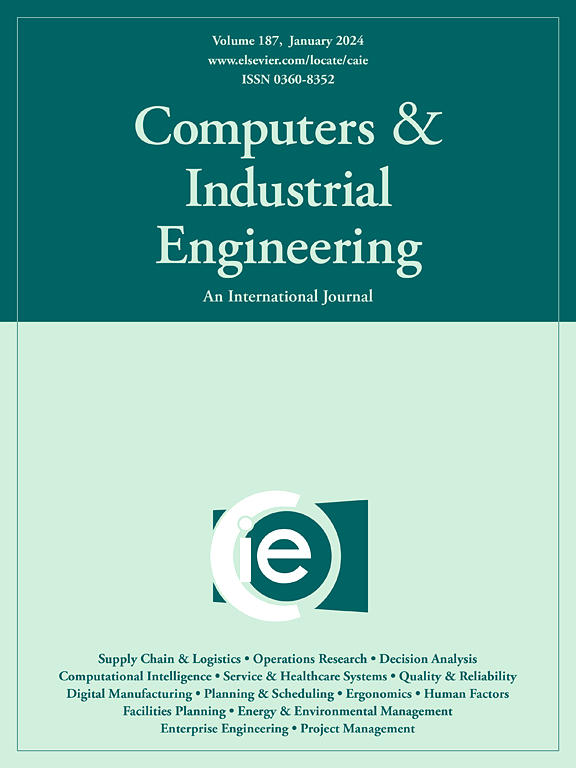迈向可持续的家庭(健康)护理:电动汽车路线的双目标制定
IF 6.7
1区 工程技术
Q1 COMPUTER SCIENCE, INTERDISCIPLINARY APPLICATIONS
引用次数: 0
摘要
发达国家预期寿命的增长导致对家庭(保健)护理服务的需求增加,原因是医院、寄宿护理设施和医务人员之间的增长率不平衡。家庭(保健)护理中心面临着若干与路线有关的实际挑战,如费用、持续时间、距离和生态影响等。这促使我们努力解决同时考虑多方面(社会、经济和环境)的路线和调度问题的操作挑战。提出了一个具有时间窗、时间依赖、多结构、多特性的双目标绿色车辆路径问题“Bi-GVRPTW-TD-2MS”模型。该模型旨在最大限度地减少患者对护理人员的不满程度,并缩短电动汽车的整体行驶距离。它结合了通过适当的充电策略在任何可用充电站充电的潜力。这个新的变体扩展了“VRPTW-TD-2MS”问题的文献,该问题是作为一个单目标函数研究的,只关注经济方面。我们使用复杂求解器给出了小规模实例的计算结果,并引入了随机通用变量邻域搜索“RGVNS”元启发式方法用于中型和大型实例。通过对比研究,我们的方法优于现有的VRPTW-TD-2MS模型的方法。实验证明了RGVNS方法在解决Bi-GVRPTW-TD-2MS和VRPTW-TD-2MS问题上的有效性和高效性。本文章由计算机程序翻译,如有差异,请以英文原文为准。
Towards sustainable Home (Health)-Care: Bi-objective formulation for Electric Vehicle Routing
The growing life expectancy in developed nations has led to an increased demand for Home (Health)-Care services due to the imbalanced growth rate between hospitals, residential care facilities and medical staff. Home (Health)-Care centers face several practical challenges related to the route such as its fees, duration, distance and ecological impact, etc. This drives our efforts to addresses the operational challenges in routing and scheduling problem considering multi-dimensional aspects simultaneously (social, economic and environmental). We propose a bi-objective Green Vehicle Routing Problem with Time Windows, Temporal Dependency, Multiple Structures and Multiple Specialties “Bi-GVRPTW-TD-2MS” model. This model aims to minimize patients’ dissatisfaction degree towards caregivers and reduce the overall travel distances of Electric Vehicles “EVs”. It incorporates the potential for recharging at any of the available charging stations through a suitable recharging strategy. This new variant extends the literature on the “VRPTW-TD-2MS” problem, which is studied as a mono-objective function with only a focus on the economic aspect. We present computational results using the Cplex solver for small-scale instances and introduce the Random General Variable Neighborhood Search “RGVNS” metaheuristic for medium and large-scale instances. The superiority of our approach over the existing methods applied to the VRPTW-TD-2MS model, is demonstrated through a comparative study. The experiments demonstrate the effectiveness and efficiency of the RGVNS method in solving both the Bi-GVRPTW-TD-2MS and VRPTW-TD-2MS problems.
求助全文
通过发布文献求助,成功后即可免费获取论文全文。
去求助
来源期刊

Computers & Industrial Engineering
工程技术-工程:工业
CiteScore
12.70
自引率
12.70%
发文量
794
审稿时长
10.6 months
期刊介绍:
Computers & Industrial Engineering (CAIE) is dedicated to researchers, educators, and practitioners in industrial engineering and related fields. Pioneering the integration of computers in research, education, and practice, industrial engineering has evolved to make computers and electronic communication integral to its domain. CAIE publishes original contributions focusing on the development of novel computerized methodologies to address industrial engineering problems. It also highlights the applications of these methodologies to issues within the broader industrial engineering and associated communities. The journal actively encourages submissions that push the boundaries of fundamental theories and concepts in industrial engineering techniques.
 求助内容:
求助内容: 应助结果提醒方式:
应助结果提醒方式:


